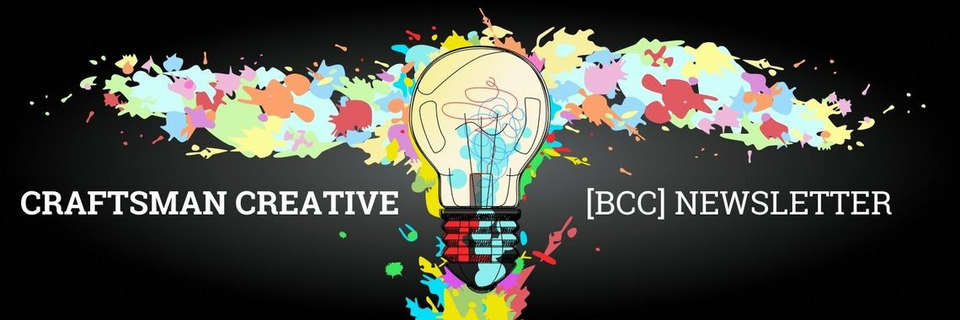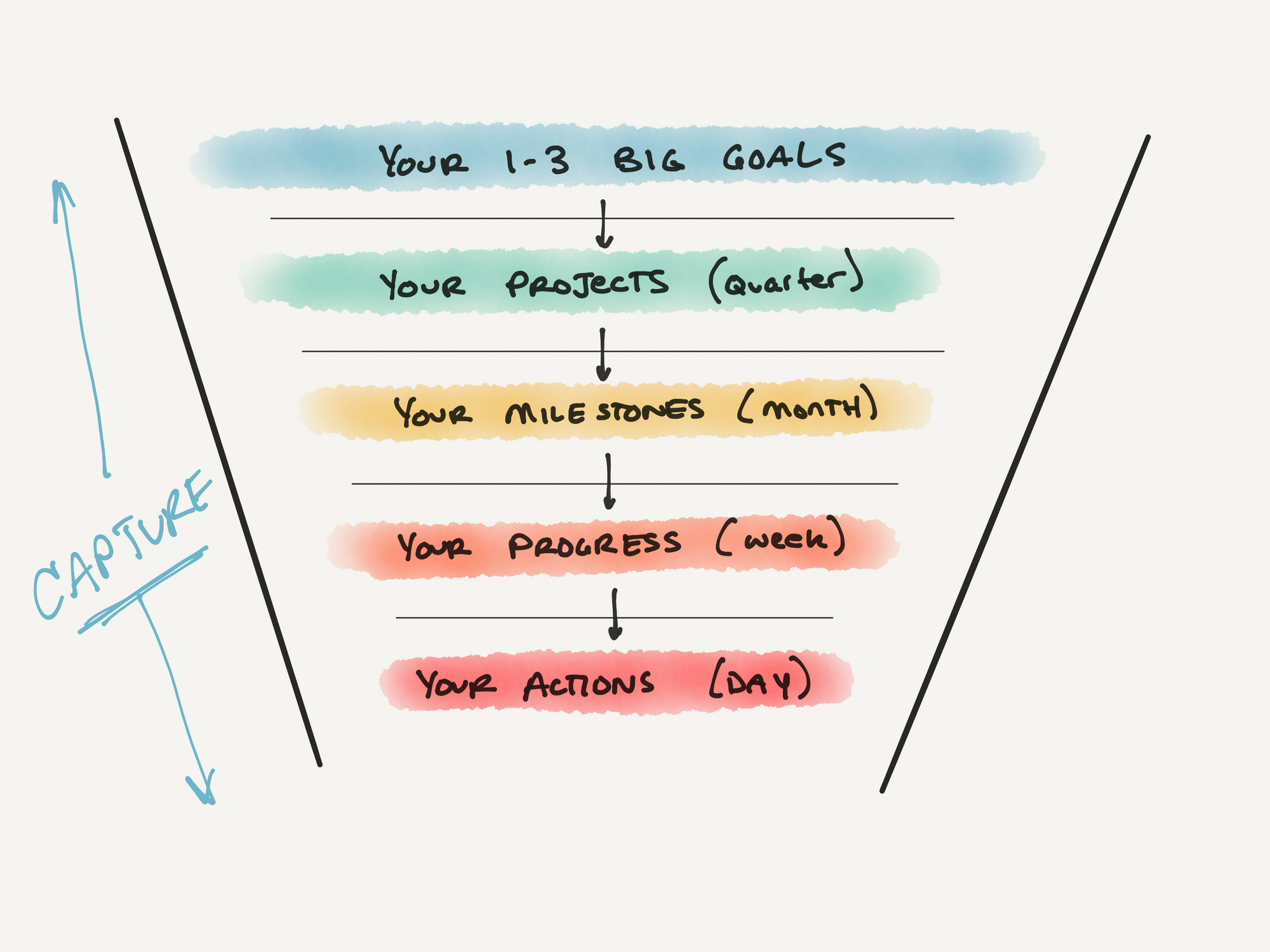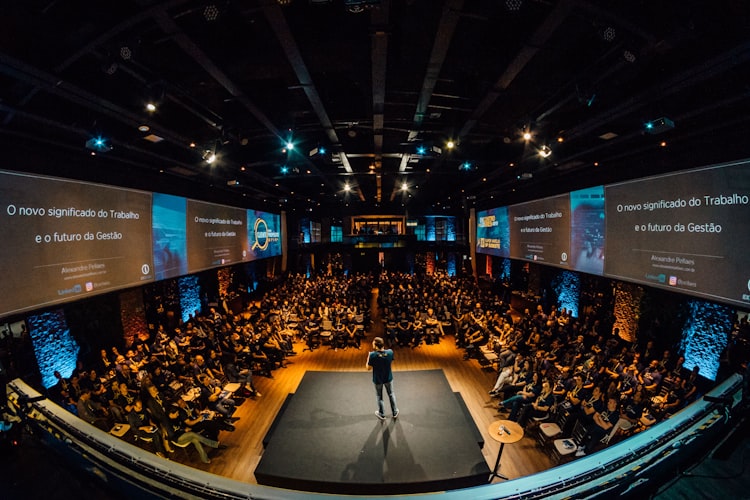How often to revisit your goals

Whew! Over the last two weeks, we had the very first 10k Challenge inside the Society of Independent Creators! What a rush. It was so fun working with ~20 creators to help them build bespoke creative businesses.
In the final session, I waited until the day before to decide what the principles and topic would be, as I had too many options and wanted to see how the challenge transpired before making the final call.
I ultimately landed on my productivity system, so that those taking the challenge would continue building their businesses using a reliable process, rather than just taking in a bunch of information and never turning it into action.
Today, I'll share a shortened version of that system with you, so that as you are working on your big goals for 2023 you can use a system that's worked for me and hundreds of other creators.
"A goal without a plan is just a dream."
~Tony Robbins
Here's a visual representation of the system:

At the top you have your 1-3 big goals for the year, the answer to the question "looking back from the end of 2023, what has to happen for you to be happy with your progress" (h/t to Dan Sullivan for that one!)
From there you progressively break those goals into smaller and smaller chunks: projects, milestones, progress, and actions.
Your big goals inform your projects
I recommend that most people trying this for the first time choose just 1-3 big goals for the year. Goals like "grow my revenue to six figures" or "become a key person of influence in my industry".
I generally only choose 4-5 because I include both personal and professional "big goals".
But how you achieve those goals comes down to what projects you choose to pursue.
Will you write a book? Start a YouTube channel? Grow your email list to 10k subscribers? Create a new product or service?
These projects generally take a few months. They're bigger than what can be done in a week or a month, but smaller than the big goals for the year.
I like to revisit these every quarter, hence the three month timeline. You can read more about that in this chapter from my book.
Every quarter, choose new projects for the next three months. This gives you a chance to check in with your big goals and make sure your projects will help you achieve them.
Your projects inform your milestones
Now that you have a few projects - generally one per big goal per quarter - you now can identify the milestones you need to hit each of the next three months to complete that project.
If you want to launch a podcast, then in month one you might have build the website, create the landing page, set up the platform, record the teaser episode, and more. Then in month two you could record the first four episodes, reach out to sponsors, and find guests. Month three is gearing up for launch, marketing, getting to 1,000 people on the email list, and launching the podcast.
Each one of these is maybe 1-2 weeks worth of work, but by checking in monthly you can ensure that you're making steady progress toward your projects and your goals.
Now is a good time to mention the "capture" in that visual. As you break down a project into the different milestones, you often won't think of everything. You may even think of other projects that you want to work on next month or next quarter.
By capturing those ideas in your notebook or digital "second brain" like I do (I use Tana, btw. Many people ask ;), now you can keep the focus on your current projects and milestones without getting distracted, and without forgetting that brilliant idea for a project.
Check in every month with your milestones, and revisit both your projects and your big goals to make sure the work you're doing is still supporting the achievement of those goals.
Your milestones inform your progress and actions
These last two steps are where the work gets done. Every week you check in with your milestones and choose what you want to get done this week. Then every day you check in with the progress you want to make and assign action items for that day.
I like to use "block time", which means I decide how much time each of those actions might take, and schedule it into my calendar for the day.
I generally reserve 9am-12pm every day for "Craftsman Time", meaning the time I work on my main project. Then I use the afternoon to schedule calls, and the other action items for the day.
Yes, this does end up with a lot more planning than you're used to. But that's the point! Too many people set big goals and the forget about them.
With this system, every day you check in for a few minutes with your projects and big goals. Every week you check in for 15-20 minutes to plan your week. Every month you check in with your milestones and projects and big goals. And every quarter you add new projects when you complete the current ones.
This guarantees that your focus is always on your big goals for the year, but in more managable, actionable chunks.
There's a saying: "how do you eat an elephant? one bite at a time..."
This is a system that helps you "eat the elephants", or accomplish your big goals. They're too big to accomplish today, this week, this month, or even this quarter. But when you take action every single day, and those actions are getting you closer to those goals, that is how you do great things in your creative life.
If you want to go deeper into this and the other systems I teach in the 10k Challenge, like audience and awareness, email engagement, your product ecosystem, and converting leads into customers, go get the recordings of the first 10k Challenge.)
PS - When you're ready, there are a few ways I can help you on your creative journey...
- Grab a copy of my book, Craftsman Creative - How Five-Figure Creators Can Build Six-Figure Businesses
- Check out the 10k Challenge and build your bespoke creative business. Use the code NEWSLETTER for $49 off!
- Work with me. I've got a few ways - both done-with-you and done-for-you - to help you grow your creative business this year. Start with this free scorecard.
Sponsored by CEXOne of the best investments I made last year was attending the inaugural Creator Economy Expo (CEX). I gave away 250 copies of my book, connected with dozens of creators - some who have since become members of my community - and realized that I can do this thing if I just stick with it. The biggest opportunity of my creative business came out of CEX... I met Joe Pulizzi there, and in the months after I pitched him on an idea for a new podcast, which became the 10k Creator and brought in $12k to my business from sponsors. I'll be attending this year's CEX in Cleveland as a presenter, leading a round table discussion. It's amazing to see what's possible in just one year. Who will you meet? How will your business change and grow? You'll never know unless you take the leap and join us May 1-3 in Cleveland for this year's CEX. Use my code CRAFTSMAN100 to get $100 off of the price of your ticket. We'll see you there!
|
LINKS TO HELP YOU GROW
One of the podcasts I've been MOST excited about is out today. Hosted by Doug McCulloch, the Deep Tracks Podcast covers the history of rock and roll in a way you've never experienced. Just check out his snippets on his Instagram page for the show (brilliant marketing, btw!) and check out the first episode.
--
Grow your digital business with Mister Growth. Francesco helps creators with e-commerce stores dominate your skills and build amazing digital products. Follow him on Instagram for more.
--
After three different attempts, I finally found the solution to turn your iPad into a proper teleprompter display, thanks to my friend Justin Moore. Check out Luna Display. *chef's kiss*
--
After searching for a solution that can help streamline creating show notes for podcasts, I stumbled upon the beta for Feather.ai. Looks promising!






Member discussion